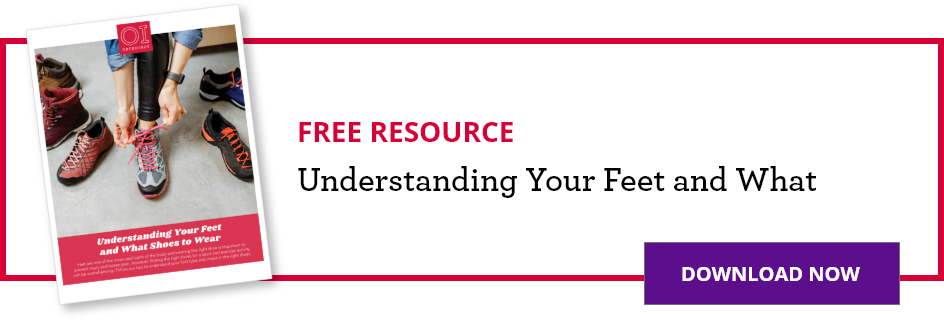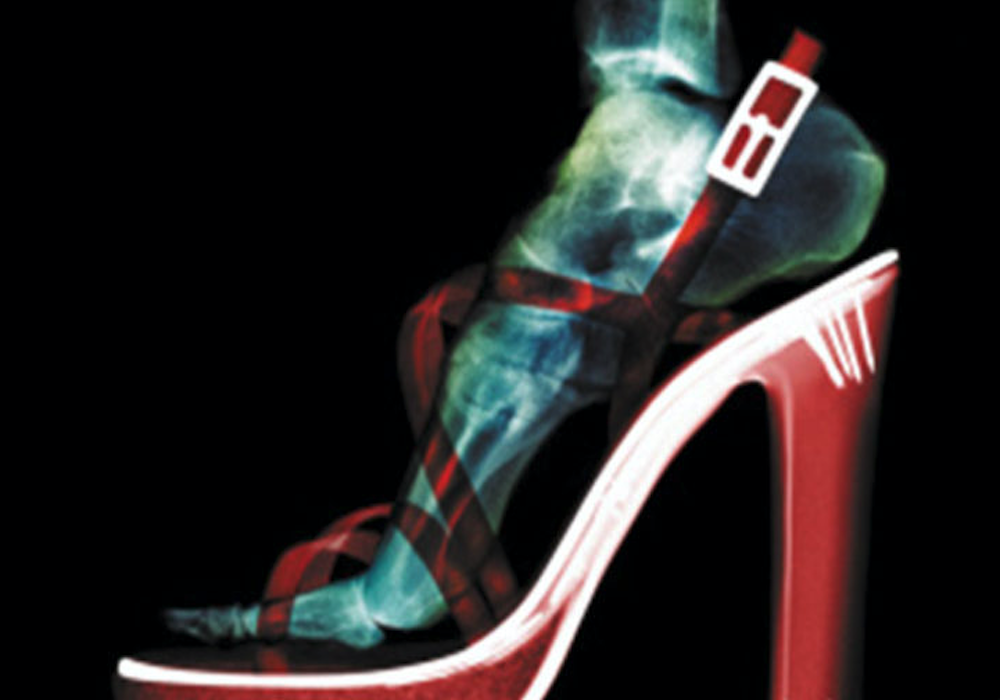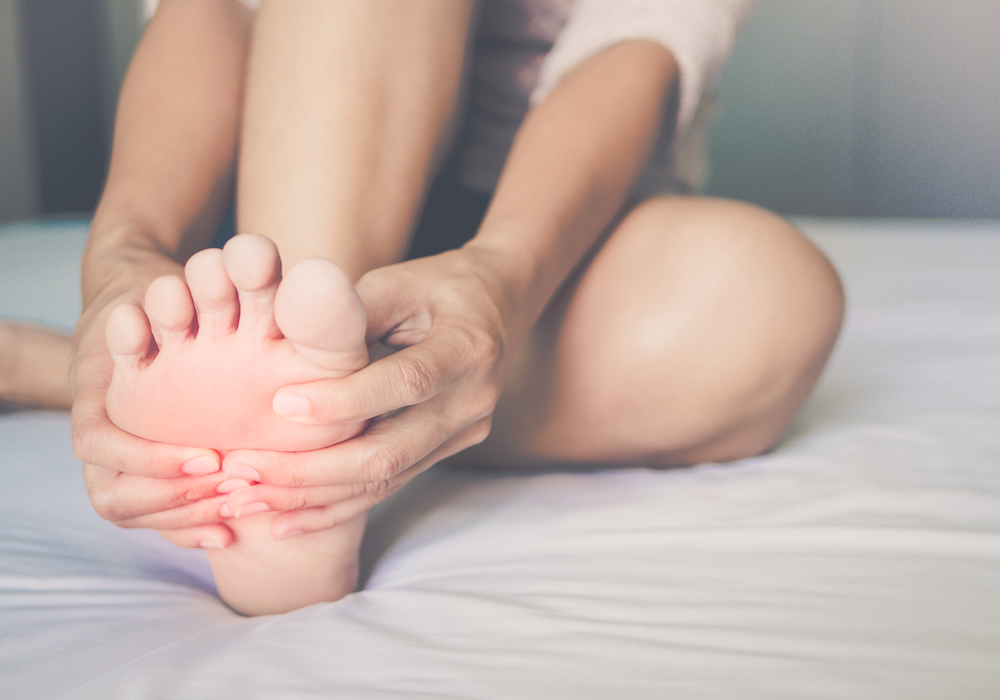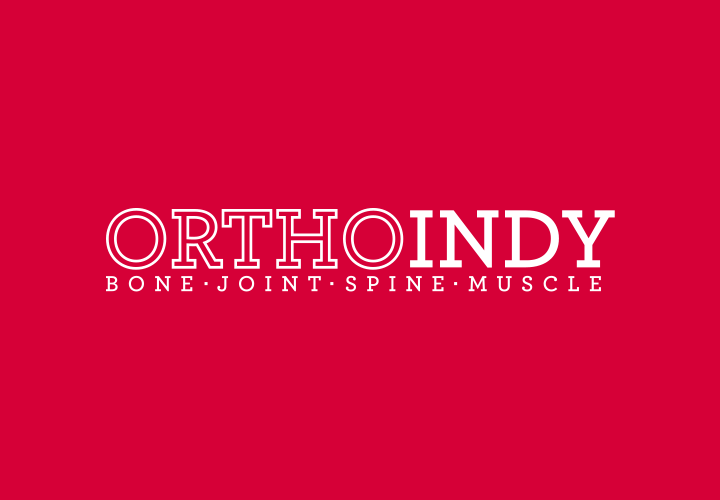THIS POST IS PART OF THE ULTIMATE GUIDE TO FOOT AND ANKLE INJURIES
What happens when you wear heels all the time?
OrthoIndy foot and ankle specialist Dr. Shea explains what happens to your feet when you wear heels.
Although I can’t comment from personal experience, high-heeled shoes have become a modern-day necessary evil. My caveman ancestors first put on rabbit-skin pelts to protect their feet from the environment. As man evolved, so did his shoes, to allow better functioning and protection, such as snowshoes and chain-mail slippers. The first high-heels can be traced to early Persian horse riders. The high-heel provided increased stability of the foot in the stirrup and prevented it from slipping forward. The functionality of shoes gave way to fashion. In the sixteenth century, royalty began wearing heels to make themselves appear taller and more prestigious. This gave way to a person of authority or wealth being known as “well-heeled.”
Today, heels are worn typically by women for aesthetic/fashion reasons and not considered practical. High-heels tend to give the appearance of longer, shapelier legs. My friends, Jimmy Choo and Gucci, describe the low-heel as less than two and a half inches, a moderate-heel between two and a half and three and a half inches and a high-heel greater than three and a half inches. Anything greater than five inches is considered “foot jewelry” and not a shoe.
Why do heels hurt my feet?
The biggest problem with high-heels is that they cause contracture, shortening of the Achilles tendon, calf muscle. This changes the entire biomechanics of the foot and ankle. The marvelous foot and ankle was created to absorb shock, propel us forward, balance on uneven ground and provide equal weight distribution. High-heels disrupt all of these mechanisms and create health problems.
High-heeled shoes are a true conundrum. Women wear them for various reasons, i.e., fashion statements, aesthetics, obligated/mandated, etc. However, 72 percent of women feel they have some type of shoe-related problem. Sadly, 42 percent said they would wear a shoe they liked, even if it was painful. Ladies, listen to your bodies, pain is telling you something is not right. Although not limb-threatening, high-heels can cause annoying, as well as significant, health issues. These problems occur when you are wearing the high-heel, as well as when you are not.
Normally when standing, weight is balanced 50 percent on the heel and 50 perfect on the ball or forefoot. As your heel rises up in a high-heel, weight is transferred more to your forefoot. This increased load causes metatarsalgia, pain in the ball of the foot, inflammation, synovitis of the toe joints, inflamed nerves producing neuritis or even neuroma and possibly even ligament rupture or stress fractures. If the toe box is pointed, then every step forcefully drives your normal foot into a constrained toe box, which leads to bunions and bunionettes. These issues may progress requiring surgical intervention if painful enough.
Muscle strength and motion are also balanced. The muscles in front of the leg pull the ankle, foot and toes upward while the calf muscle creates push off and flexes the toes and the foot for balancing. A high-heeled shoe shortens the calf muscle. The shortened/contracted calf muscle causes the anterior muscles to work harder to keep the foot and ankle balanced. In doing so, this may lead to tendinitis, but more commonly it creates hammertoe and claw toe deformities as the tendons to the toes try to pull up against the overpowering forces to the bottom of the foot; again, all created from a contracted Achilles tendon.
The position of the foot in a high-heel not only causes the Achilles tendon to shorten, but also the plantar fascia, a strong ligament in the bottom of the foot that runs from the heel out into the toes and supports the arch of your foot. Plantar fasciitis is generally not symptomatic when wearing the heel as the position of the heel takes the stress off the plantar fascia; however, it becomes very painful when one tries to wear a flat shoe.

Another difficulty with a contracted Achilles tendon is that it limits the in and out or sideways motion of your hindfoot, the joint below the ankle. This motion normally allows the foot to accommodate uneven ground and ball shock absorption. When you decrease the ability to accommodate uneven ground, your tendons need to work harder to keep the foot balanced. This may lead to tendinitis and subsequent tendon degeneration. A tight Achilles tendon will also worsen the pain associated with a flat foot deformity and increase the instability in a high-arched foot due to the consequences of the muscle imbalances. The shortened Achilles tendon may also make it difficult to treat flat feet and high-arched feet with orthotics, which may necessitate one having surgery.
People who wear high-heels also have a shorter and more forceful stride with less shock absorption. The raised heel also alters gait mechanics, which may lead to knee arthritis and back pain. High-heels also produce instability and balance issues. When the small heel of the high-heeled shoe contacts the ground, it usually causes a wobbling thrust on both your ankle and knee, which can lead to tendinitis and osteoarthritis. Due to the shape of the ankle bone (talus) when you wear a heel, there is less inherent stability in the ankle joint. This makes it easier to sprain your ankle, even when walking on a level surface. Lastly, when wearing high-heels, it would be difficult to run away from or defend one’s self from an attacker.
As an advocate for truth, high-heels do have two health benefits. They increase the tone of the pelvic floor, which may decrease urinary incontinence and they also may help shorter people function in a world designed for normal-height individuals.
How can I stop my feet from hurting in heels?
Even after stating the obvious downside of wearing high-heels, women will wear them. For you, I have a few words of advice. First, try to wear a high-heel of less than one-third of the time you are on your feet. Also, please try to maintain an Achilles tendon stretching program, as this is the basis for the majority of the problems. Secondly, please listen to and answer your body when it complains of pain. Thirdly, if you must wear heels, there are a few characteristics of an acceptable high-heel: A wedge is better than the more stylish drop-off type of heels, a thicker and more stable heel is better and open-toed high-heels are better than closed-toed. If you have to wear a closed-toe shoe, get one that fits you snugly so that your foot doesn’t slide into the toe box. Lastly, any type of cushioning underneath the forefoot would help.
Learn more about foot and ankle treatment at OrthoIndy
Schedule an appointment
Your well-being is important to us. Click the button below or call us to schedule an appointment with one of our orthopedic specialists. If your injury or condition is recent, you can walk right into one of our OrthoIndy Urgent Care locations for immediate care. For rehabilitation and physical therapy, no referral is needed to see one of our physical therapists.





